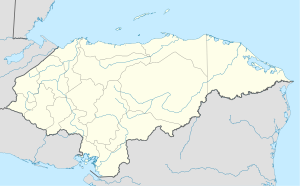San Fernando de Omoa
|
Omoa Omoa |
|
|---|---|
 |
|
| Nickname(s): Omoa | |
| Coordinates: 15°46′26″N 88°2′11″W / 15.77389°N 88.03639°W | |
| Country |
|
| Department | Cortés |
| Foundation | 1752 |
| Area | |
| • Total | 382 km2 (147 sq mi) |
| Population (2015) | |
| • Total | 47,287 |
| • Density | 120/km2 (320/sq mi) |
| Climate | Af |
Omoa is a town and a municipality in the Department of Cortés of Honduras. Omoa is located on a small bay of the same name 18 km west of Puerto Cortés on the Caribbean Sea coast.
Omoa is both a municipality and a small town located along the Northwest Caribbean coast of Honduras. It is populated by about 30,000 people distributed within an area of 382.8 km².
In 1536 Omoa was a small "pueblo de indios" allocated in repartimiento by Pedro de Alvarado to Luis del Puerto along with the nearby Indian town of Chachaguala. But by 1582 Omoa had ceased to exist as a viable community.
Repeated pirate raids on coastal towns along the Caribbean coast of Central America led the Spanish Crown as early as 1590 to begin looking for a new defensible port for the Captaincy General of Guatemala to export its goods to Spain. This initial study by Antonelli, and many subsequent ones, all pointed to the bay at Omoa as the most defensible location along the coast west of Trujillo (which already had a fort).
Omoa was founded again in 1752 as a Spanish colonial town. The then governor of Honduras, Pantaleón Ibánez, described that the town they planned would include a hospital, a building for the royal treasury, a church, warehouses, barracks for soldiers, and houses for the officers. The town itself was to house the people who would build and occupy the two Spanish forts (El Real, and San Fernando de Omoa) which would guard the bay. Construction of El Real began in 1752 and was finished around 1756. El Real was used to defend the port town while the much larger fort of San Fernando de Omoa was built next to it. San Fernando de Omoa was finished around 1774. This historic place had as its main purpose to protect against the pirates; the silver cargos originating from the mines of San Miguel of Tegucigalpa that often left from Omoa to Spain. Ironically, the construction of the fortress did not end until piracy had significantly declined. After the independence of Honduras in 1821, the fortress was used as a prison by the Honduran authorities through the 1950s.
...
Wikipedia

